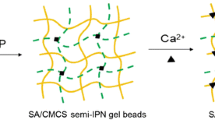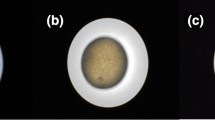Abstract
Purpose
Oral delivery of peptide/protein is quite difficult due to physiological barriers. Encapsulation of these drugs in the suitable biopolymeric matrix could protect the drug as well as increase the residence time of the formulation. Mucoadhesive biopolymers are being widely investigated for this purpose.
Methods
We have fabricated insulin-loaded chemically crosslinked chitosan-alginate macrobeads of approximate size 3 mm per bead. The beads were characterized for surface morphology and polymeric interaction using SEM, EDX, and FTIR, respectively.
Results
The swelling profile and insulin release were analyzed in water and PBS for 9 h. The surface had uniform undulations as observed by SEM. EDX confirmed the chemical crosslinking of chitosan and alginate. FTIR further confirmed the interaction among the polymers. The swelling study revealed a gradual increase for some time and then a decrease in weight possibly due to the disintegration of beads. A cumulative release of approximately 35% was observed by the end of 9 h in both the dissolution medium.
Conclusions
This work is done to investigate the possibility of release of protein/peptide drugs from polysaccharide biopolymer-based blended hydrogel matrix for possible non-invasive delivery of such drugs orally. Here, we have formulated mixed polyelectrolyte hydrogel beads of chitosan and alginate encapsulating insulin as the model drug. Our work shows a sustained release of insulin from the chitosan-alginate beads.








Similar content being viewed by others
References
Richard J. Challenges in oral peptide delivery: lessons learnt from the clinic and future prospects. Ther Deliv. 2017;8(8):663–84.
Lundquist P, Artursson P. Oral absorption of peptides and nanoparticles across the human intestine: opportunities, limitations and studies in human tissues. Adv Drug Deliv Rev. 2016;106(Pt B):256–76.
Yun YH, Lee BK, Park K. Controlled drug delivery: historical perspective for the next generation. J Control Release. 2015;219:2–7.
Vilar G, Tulla-Puche J, Albericio F. Polymers and drug delivery systems. Curr Drug Deliv. 2012;9(4):367–94.
Kumar A, Vimal A, Kumar A. Why chitosan? From properties to perspective of mucosal drug delivery. Int J Biol Macromol. 2016;91:615–22.
Lee KY, Mooney DJ. Alginate: properties and biomedical applications. Prog Polym Sci. 2012;37(1):106–26.
Kumar A, Bharti SK, Kumar A. Therapeutic molecules against type 2 diabetes: What we have and what are we expecting? Pharmacol Rep. 2017;69(5):959–70.
Takka S, Gürel A. Evaluation of chitosan/alginate beads using experimental design: formulation and in vitro characterization. AAPS PharmSciTech. 2010;11(1):460–6.
WHO expert committee on biological standardization (2010) http://www.who.int/biologicals/expert_committee/BS_2143_Human_Recombinant_Insulin_final.pdf. Accessed 11 Jan 2019.
Arbit E, Kidron M. Oral insulin delivery in a physiologic context: review. J Diabetes Sci Technol. 2017;11(4):825–32.
Accessed from https://clinicaltrials.gov/ct2/show/NCT03430856. Accessed 6 January 2021.
Khedkar A, Lebovitz H, Fleming A, Cherrington A, Jose V, Athalye SN, Vishweswaramurthy A. Pharmacokinetics and pharmacodynamics of insulin tregopil in relation to premeal dosing time, between meal interval, and meal composition in patients with type 2 diabetes mellitus. Clin Pharmacol Drug Dev. 2020;9(1):74–86.
Hu Y, Peng J, Ke L, Zhao D, Zhao H, Xiao X. Alginate/carboxymethyl chitosan composite gel beads for oral drug delivery. J Polym Res. 2016;23:129.
Hari PR, Chandy T, Sharma CP. Chitosan/calcium-alginate beads for oral delivery of insulin. J Applied Polym Sci. 1996;59:1795–801.
van der Merwe SM, Verhoef JC, Verheijden JHM, Kotze AF, Junginger HE. Trimethylated chitosan as polymeric absorption enhancer for improved peroral delivery of peptide drugs. Eur J Pharm Biopharm. 2004;58:225–35.
Dunnhaupt S, Barthelmes J, Rahmat D, Leithner K, Thurner CC, Friedl H, et al. S-Protected thiolated chitosan for oral delivery of hydrophilic macromolecules: evaluation of permeation enhancing and efflux pump inhibitory properties. Mol Pharmaceutics. 2012;9:1331–41.
Author information
Authors and Affiliations
Corresponding author
Ethics declarations
Conflict of Interest
The authors declare that they have no conflict of interest.
Additional information
Publisher’s Note
Springer Nature remains neutral with regard to jurisdictional claims in published maps and institutional affiliations.
Rights and permissions
About this article
Cite this article
Kumar, A., Thakur, P. & Kumar, A. In Vitro Evaluation of Insulin Release from Chitosan-Alginate Macrobeads. J Pharm Innov 17, 546–554 (2022). https://doi.org/10.1007/s12247-021-09534-9
Accepted:
Published:
Issue Date:
DOI: https://doi.org/10.1007/s12247-021-09534-9




